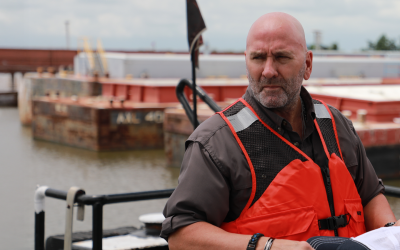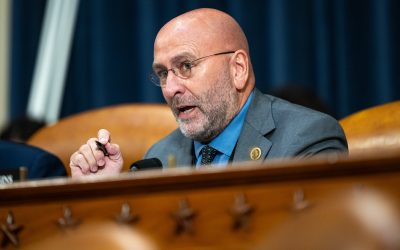Rep. Clay Higgins visited the Port of Lake Charles Monday to announce that, after rigorously lobbying in Washington to secure more funds for dredging the Calcasieu Ship Channel, he succeeded in getting an additional $10 million from the Army Corps of Engineers’ discretionary fund.
The extra $10 million combined with the $22 million already dedicated to channel dredging in the 2017 federal budget brings the total to $32 million — the most the channel has received in several years. Last year the total was $26 million.
Port officials say it’s historically rare to get $10 million from the discretionary fund, which is set aside for priority projects. Bill Rase, executive director at the port, said the money will help bring the channel closer — although not all the way — to its advertised dimensions: 400 feet wide by 40 feet deep.
“It’s enough to keep it open. It’s not enough to get it to full dimension,” Rase said. “But it’ll be close. It’ll be really close, which is really better than we’ve been in three or four years.”
Rase said right now the channel is about 40 feet deep but far from 400 feet wide in some places.
“As the ships moves up and down the channel, their keeping the bottom dredged, but the sides will fill in,” Rase said. “Then you can’t pass two ships, and it gets to be one-way traffic. Then safety gets to be a larger issue.”
He said the $32 million total is a product of about nine years of fighting for awareness in Washington about the channel’s dredging needs. Higgins’ zealous approach to the issue also helped make this year’s efforts especially successful, Rase said.
“It has been a long time since we’ve had strong leadership in Washington to get the whole delegation together,” he said. “We’ve been working with everybody to try to keep Calcasieu in the forefront of the dredging situation, and Congressman Higgins has been very strong in that area since he has been office.”
Higgins said it wasn’t hard for him to be passionate about the issue when he learned that the area had an unprecedented amount of capital investment planned for the next decade, all of it centered on the channel. He also noted that at the time of the channel’s construction the federal government committed to funding channel dredging, but hasn’t done so for many years because of the nation’s tight budget.
“This was an important project because it has such a mass economic impact on the state, and it represents a very clear failure of the federal government to fulfill a promised service,” Higgins said. “I recognized that having the Calcasieu Ship Channel dredged properly was perhaps the most significant single economic impact we could make in our district and in our state.”
He said he struck up an unexpected friendship with Colonel Michael Clancy, New Orleans district commander for the corps, who partnered with him to secure additional funding for the channel.
“I was predisposed not to like him because he was the corps, but yet from the moment this man walked in my office I knew he and I were going to be able to be partners,” Higgins said.
He said he also sent a letter to President Trump signed by every member of the Louisiana delegation outlining the needs of the channel.
After numerous phone calls, meetings and visits with Southwest Louisiana industries, Higgins was able to gain support. But he said, for him, the battle isn’t not over. He’s looking to get $40 million dedicated next year.
“We’re going to continue to push. I won’t stop. I’m doing my best,” Higgins said.
Rase said the channel is constantly refilling with fresh sediment from the north. The corps, in turn, collects hundreds of thousands of cubic yards of sediment from it annually.
Although the corps funds dredging activities, the port is tasked with funding up to 25 percent of the cost of constructing new dikes on spoil sites to store the sediment, Rase said. This could amount to $80 million over the next 20 years, and the port is working with the state to finance a solution.
The Port Board recently voted to dedicate revenues from its ad valorem tax for the next five years, about $15 million, to funding its portion of spoil site preparation for storing the sediment.



